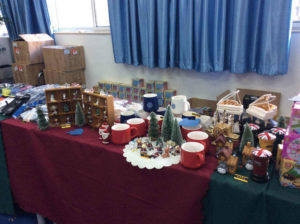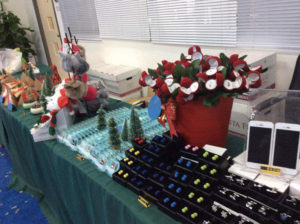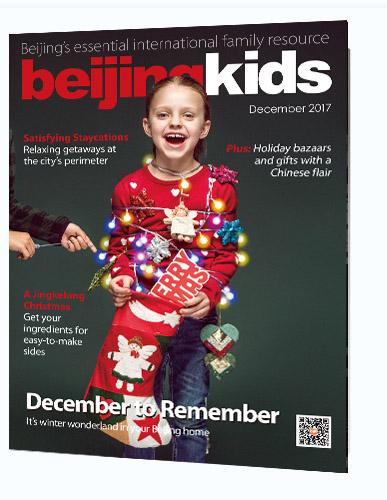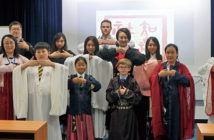December is a time for giving and sharing. Even if you don’t celebrate Christmas, most cultures remember the time when our ancestors would have huddled together against the midwinter cold, lit fires, and feasted to help each other through the short days and long nights.
Yet for children, the holiday season can become all about material possessions, about writing lists for Santa, about longed-for toys, clothes or video games. But how can we, at a level appropriate to their age and development, ensure that our kids understand the joys of giving as well as receiving? We visited two Beijing schools to find out about their innovative approaches to this issue.
Beijing International Bilingual Academy (BIBA) was founded in 2006 and has grown rapidly, with 1,350 students at its expansive Shunyi campus. The school has an active and enthusiastic Parent-Teacher Association (PTA), and it was their initiative to set up what has become a BIBA seasonal tradition: the Santa Shop. PTA members Karen, who has a daughter in Grade 6, and Ceci, whose daughter is in Grade 2, told us more.
“It was established in 2009,” Karen said, “and now runs every year. Our mission is to let the students learn how to give love to somebody: to family members, to their ayi, their driver, to everyone! We provide an opportunity for them to buy small things, so they can get presents without spending a lot of money.”
 Volunteers clear out the school’s Conference Center and transform it into a winter wonderland. “The items in the shop are all new,” Ceci told us. “We start ordering a month in advance: all sorts of things, for example, mini teddy bears, t-shirts, and pens. Over 30 volunteers staff the shop, which is open for four days in the first week of December, and each class comes for 20 or 30 minutes. But some children come back later, in their own time.”
Volunteers clear out the school’s Conference Center and transform it into a winter wonderland. “The items in the shop are all new,” Ceci told us. “We start ordering a month in advance: all sorts of things, for example, mini teddy bears, t-shirts, and pens. Over 30 volunteers staff the shop, which is open for four days in the first week of December, and each class comes for 20 or 30 minutes. But some children come back later, in their own time.”
“I know that’s true, because my children do it!” said Adam Winterhof, Director of Marketing and BIBA parent. “In every class, the teacher gives out a sheet for each student to list out what they want to buy, staying within their budget. Older children can do that independently, while teachers help the younger ones. And this year the shop is open on one day for families, so parents can see how their kids enjoy shopping there.”
But the shop has a wider purpose. “Our second mission is to raise money for charity,” Karen said. “In past years we’ve given the proceeds to Roundabout, and to a migrant school to support their rent.
“This year we’re going to use the money for a Dream Maker project, for seriously ill children to have a small wish fulfilled. We started the project this year, and we already have one wish completed, with five more on the way, thanks to the students. On BIBA Day, one of the grades chose a flea market for their project, and the result was that we were able to provide for this wish.”
 Granting the wish proved to be a moving experience for all concerned. “A young boy had his ninth birthday over the National Holiday week. He wanted a big cake he could share with everyone at the hospital because he was too ill to eat it himself. Ceci and her family went with a Lego cake made by the Bread of Life Bakery, and the Lego store in Shine Hills donated a very special Lego set.
Granting the wish proved to be a moving experience for all concerned. “A young boy had his ninth birthday over the National Holiday week. He wanted a big cake he could share with everyone at the hospital because he was too ill to eat it himself. Ceci and her family went with a Lego cake made by the Bread of Life Bakery, and the Lego store in Shine Hills donated a very special Lego set.
“He stood up to receive his gifts, even though he wasn’t on his feet very often, because of his illness. His parents were visibly moved, happy but also emotional. The birthday was a big milestone for him, but also a big reminder of his current situation.”
The BIBA PTA hope to be able to grant another four wishes before Christmas. “One child wants to go to Hainan, for a holiday. Another wants to play video games with a professional team. One little girl loves painting, so she wants a set of paints and brushes. They’re small wishes, but maybe their last wish, so we will push to see them completed quickly.”
The Santa Shop is an effective money-raising event, Winterhof told us. “We raised RMB 80,000 from the Santa Shop alone last year. Each year we need more space. The variety of items each year is bigger, as each year the school has grown. There are more things in there for mom and dad, so kids can get them a surprise.”
There are plans too for further growth. “We want to make it into a big fair for the community, to invite parents and people from other schools,” Karen said. “We plan to involve things made by the students, such as their artwork, to be included in the sale or auctioned to parents. These are the next logical steps to make the Santa Shop even more special, and raise even more money for charity.
And while the event is Christmas-themed, it is popular with BIBA’s international, multi-cultural students and their families. “While it’s called the Santa shop,” Winterhof said, “it’s focused on the idea of creating generosity. It’s usually been well received, whether or not they celebrate Christmas as a festival. It’s more about the child being able to get a present for their parents, to say thank you for all they do.”
Across Shunyi, another school has taken gratitude as a theme which unites all cultures. Hyde Academy originally opened in 1993, as Beijing City Jinghua Private School, but was fully refurbished and relaunched under its new name in 2016. As a growing school, it is evolving its own unique traditions, which reflect its ethos.
“Holidays are a great opportunity to remind students of the many ways in which we can share our wealth of resources, including time, effort, and money, with others,” said Jennifer Sachs, the school’s Principal. “At Hyde Academy, our five core values – curiosity, care, cooperation, respect, and be your best – form the foundation for the greater goal of communicating with others throughout of community and the world. As part of that goal, we will be focusing our energies on helping the Migrant Children’s Foundation (MCF) this school year, beginning with a Secret Santa Celebration in December organized by our Dean of Students.”
We talked to Karen Killeen, Dean of Students, to learn more. “It’s about recognizing that we’re a bilingual school and that we have students from English-speaking countries and Chinese speakers,” she said, “and also recognizing that we share the same values around gratitude, but we have different festivals and ways of celebrating this.
 “This time of year is a season of expressing gratitude for all cultures, so we’re doing it now to fuse Thanksgiving, Christmas and Chinese New Year. We’re doing two things: first, we’re encouraging students and teachers to buy a present, bring it into school and put it under a fir tree in the foyer. The present should cost between RMB 50 and RMB 100, and not be gender-biased. Then, on December 8, we’ll have the Big Wrap where all students will wrap their present. The gifts will be left under the tree at Christmas.”
“This time of year is a season of expressing gratitude for all cultures, so we’re doing it now to fuse Thanksgiving, Christmas and Chinese New Year. We’re doing two things: first, we’re encouraging students and teachers to buy a present, bring it into school and put it under a fir tree in the foyer. The present should cost between RMB 50 and RMB 100, and not be gender-biased. Then, on December 8, we’ll have the Big Wrap where all students will wrap their present. The gifts will be left under the tree at Christmas.”
This has already provided an opportunity to discuss wider ethical issues, Killeen told us. “The students were very enthusiastic about the present being non-gender specific because that has sparked off a debate about gender-specific toys, and the advertising that goes on around it. The buying of the presents is also an opportunity to think about gratitude, about being thankful for what we have, and others may not have.”
While presents under the tree are a western tradition, the second aspect of the celebration reflects Chinese culture.
“At the same time,” Killeen said, “we will have lots of cards which look like red envelopes, with ‘to’ and ‘from’ on each side. Staff and students are encouraged to write a message of gratitude. It might be inspired by an event that’s happened in their life or a particular person, or it might see the bigger picture, and relate to a global issue.
“The cards will be hung from the fir tree, which we’re calling a ‘Gratitude Tree’, fusing the idea of the Christmas tree with the theme of gratitude. Having them on the tree as a focal point in the foyer will encourage people to read what others have written. Then, before we break up for Chinese New Year, they’ll be encouraged to take their letters of gratitude from the Gratitude Tree, and if appropriate share them with the person they’re addressed to.”
The gifts will also be handed out at Chunjie rather than Christmas, Killeen told us. “Ahead of Chinese New Year, we’ll present them to MCF to distribute. We are hoping that the children will be able to accompany us.”
These activities are woven into the school’s wider program of moral and cultural education. “This is not an add-on, it’s built into the lesson, so children have a chance to think and reflect thoughtfully about what gratitude means. It’s part of our program to encourage global thinking, global mindsets, while still respecting Chinese values and western values. It links them back to the reason why we have these celebrations, and why these celebrations have been around for hundreds of years.“We’ll talk about the history of the three festivals, think about gratitude in a subject-specific way, like a piece of music might have been inspiring for you – how does it make you feel? It’s related to the topics the students are working on at the moment.
“And if a child or student has time to reflect, we hope that that will encourage inspiration; as they grow older, they will inspire others by the things they do or the activities they get involved in.”
Photos: Courtesy of BIBA and Hyde Academy
This article appeared on p40-43 of beijingkids December 2017 issue.





